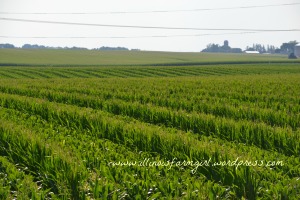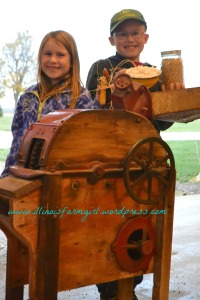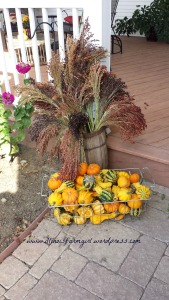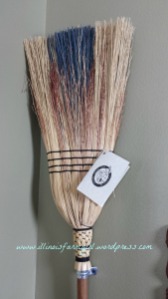Scientifically, there are five types of corn. Michael at Minnesota Farmer wrote a great post about these types – field or dent, sweet, popping, flint (Indian or decorative) and pod corn. Within each of these categories, there are hundreds of variations of hybrids. Brian at The Farmers’ Life writes about waxy corn, and Amanda at The Farmer’s Daughter USA write about field corn.
 On our farm our bread and butter, so to speak, is field corn, and this is what you see the most when driving through the countryside. Field corn is also dent corn, commercial corn or yellow corn. The difference among field corn hybrids is starch or oil content, number of days between planting and harvest, tolerance to drought, stalk stability, etc.
On our farm our bread and butter, so to speak, is field corn, and this is what you see the most when driving through the countryside. Field corn is also dent corn, commercial corn or yellow corn. The difference among field corn hybrids is starch or oil content, number of days between planting and harvest, tolerance to drought, stalk stability, etc.
It is a diverse grain that is grown for food, feed and fuel. Corn sugar, corn starch and corn oil comes from field corn. The corn animals eat, squirrels included, is field corn, and ethanol is made from field corn. We sell to markets that support all of these functions.

This is a cut seed field. The ‘female’ rows have their tassels cut in order to accept only the pollen from the ‘male’ rows. This is how we get a hybrid.
We also grow seed corn on our farm, which is field-corn seed. Other farmers including us will purchase this seed to plant for the coming years. Seed corn is a fickle crop, requires a lot of attention, but pays for the investment. This is where we facilitate cross-pollination between two types of corn – one containing a certain set of genes we’d like to see combined with another set. That’s the very generic elevator explanation. This summer, I’ll delve into seed corn a bit more.
 You may have read previously about our kids entrepreneurial efforts as popcorn farmers. In year two, they sold their entire crop in 48 hours, shipped to 5 different states, and created a waiting list for their 2015 crop. They are starting to learn more about the specificity of growing popcorn vs. field corn. They are reading about the growing season, the insect and disease pressures and how and when to harvest.
You may have read previously about our kids entrepreneurial efforts as popcorn farmers. In year two, they sold their entire crop in 48 hours, shipped to 5 different states, and created a waiting list for their 2015 crop. They are starting to learn more about the specificity of growing popcorn vs. field corn. They are reading about the growing season, the insect and disease pressures and how and when to harvest.
For our families’ use we grow a few rows of sweet corn every year. Usually, the day after our county fair, we head out to “do” corn. Doing corn in this family means putting it up for winter, freezing it. It has been a family tradition for as long as I can remember.
 I’ve always planted a bit of Indian corn or decorative corn each year, and my little bit yields more than I can use.
I’ve always planted a bit of Indian corn or decorative corn each year, and my little bit yields more than I can use.
I also discovered broom corn a few years ago. It is another fun crop to use for fall decor. It does not shoot an ear, but instead has a larger tassel, which was used at one time to make brooms. Thus the name. In fact the Wagner Historic Farm in Glenview, IL grows broom corn for this very purpose. I have one hanging on my wall. (It’s too pretty to use.)
So, with all this corn growing on one farm, are we concerned about cross pollination? The short answer is, “No.” In fact, we plant the 400 acres that surrounds our house to field corn every year. On the east edge of the field, just behind the house, we add two rows of sweet corn, three rows of popcorn and in the corner patch, a short stretch of broom and Indian corn. The only cross-pollination we’ve had is between the popcorn hybrids.
Cross-pollination becomes a bigger deal when dealing with seed corn. I wrote about that extensively for The Genetic Literacy project when answering the question, “Do GMO farms ‘contaminate’ neighboring fields?“. All our seed fields are planted in isolation with upwards of 300 feet between them and the next field.
So, the next time someone asks, “what do you grow?” I’ll respond, “corn” with conviction. Because that is what we grow on this farm.







Reblogged this on iSimpleTypeApp News and Support.
Thank you for this post! My grandmother grew up on a corn and soybean farm in Sheldon, Illinois, and though we have since sold the remaining farmland, I always wondered what, exactly, it was that they grew. I found your blog post during some lazy Googling- it was informative without being overwhelmingly so. 🙂
Thank you for the compliment. I’m so glad it helped out.